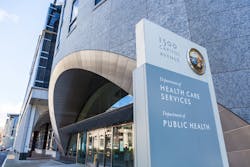California Developing Alternative Payment Model for FQHCs
California is one of four states, along with Oregon, Washington and Colorado, that is developing an alternative payment model that converts Medicaid rates for Federally Qualified Health Centers to a capitated per-member per-month (PMPM) payment.
The state’s Department of Health Care Services (DHCS) has said that FQHCs choosing to participate in this APM would be able to move away from the traditional Prospective Payment System (PPS) to a front-loaded reimbursement methodology that more closely aligns with evolving practice needs and the effective delivery of healthcare services.
DHCS is planning to submit a State Plan Amendment to the Centers for Medicare & Medicaid Services in late 2023 to seek approval to implement the FQHC APM, with a proposed implementation date of Jan. 1, 2024.
In order to incentivize enhanced healthcare quality for impacted Medi-Cal members, the new APM methodology will be linked to specific quality metrics that must be satisfied by the participating FQHC as a condition of continued participation in the APM program.
The state says it will work to align measures in CalAIM, Medi-Cal Managed Care, and Pay-for-Performance programs to ensure greatest impact in quality targets.In addition to reducing administrative burden, another goal is data-informed innovation that encourages deeper health information exchange between managed care plans and FQHCs. The hope is that delivery reform focused on value, outcomes, and investing in early intervention and primary care result in per capita cost decreases to the larger Medi-Cal program. Developed by leveraging base year managed care utilization data, each participating FQHC will receive monthly payments equivalent to their total, projected PPS payment entitlement in the form of an APM Per Member Per Month (PMPM) rate, paid across all assigned members attributable to each Managed Care Plan (MCP) with whom the participating FQHC has contracted. Upon implementation, DHCS will be including necessary PMPM rates in monthly capitation paid to MCPs, who will then be expected to remit appropriate PMPM payments to participating FQHCs, who have provided covered services to their Medi-Cal members.
DHCS also said it would be implementing safeguards to ensure that participating FQHCs receive their full PPS entitlement. On an annual basis, the state will verify that payments made to participating FQHCs are sufficient and comply with all APM requirements, and that participating FQHCs did not experience variation in utilization. In the event the PMPM payments are determined to be inadequate, DHCS will pay the participating FQHC the difference between the total PMPM amount paid and the amount that the entity would have received under the traditional PPS rate methodology.
The California Health Care Foundation recently published an Implementation Guide for the California Federally Qualified Health Center Alternative Payment Model. This guide, developed for leaders and staff in FQHCs that are considering or have committed to participating in the California FQHC APM, includes practical resources for reimagining and redesigning how an FQHC delivers care so it can be successful in the FQHC APM.
As the Implementation Guide states, the shift to this value-based payment arrangement has the potential to remedy some longstanding issues by:
1. Giving health centers flexibility to provide care in the ways patients need and want
2. Allowing health centers to make critical infrastructure improvements
3. Helping improve patient outcomes
4. Helping deliver comprehensive, team-based, patient-centered care
5. Improving accountability by rewarding health centers that improve quality of care
DHCS said it also wants to explore FQHCs taking on some level of risk over time.


